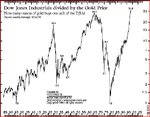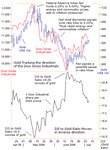Found an article by a private individual on Gold-Stock Market correlation (full article on blog can be found here). I'll just quote some of the main points made in the article...
The chart below that I 'borrowed' gives a visual idea of the correlation... So, inflation is bad for the market, and thus gold is seen as a hedge because of its residual (or intrinsic) (I think) value. "uncertain times", I presume, would encapsulate such things as war or recession - not sure what else though.
So the chart below shows the inverse-relationship between gold and the stock market. The fairly rapid fall in the price of gold while the market rises from the low in March. And apparently the US Dollar is even more inversly correlated with gold than the stock market is - more on this later...
so if Gold has an inverse relationship with the dow. We should be looking for a sell off, of Gold (or an lease for Gold to not rise further) as a confirmation that Greys long call at the moment is correct. (ie the money that was paniced into gold when the financials fell over, will return to the stock market.)
however the bigger historical cycle between Gold and the dow (looooong term) would suggest that gold has further to rise (or the dow has further to drop) the ratio dow/gold is around 15 at the moment comming of its peek of 30ish in the late 1990's early 2000's?????????
belflan



